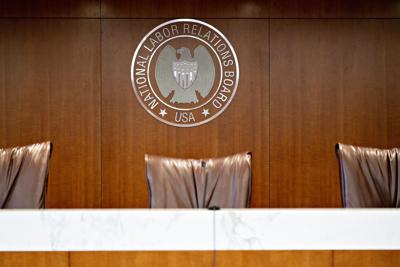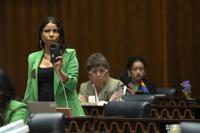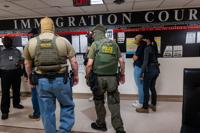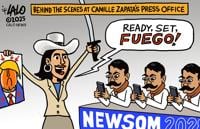
The National Labor Relations Board (NLRB) seal hangs inside a hearing room at the headquarters in Washington, D.C., U.S., on Monday, Sept. 30, 2019. (Andrew Harrer/Bloomberg via Getty Images)
This article was produced by Capital & Main. It is published here with permission.
“They have shown that they will fight to the bitter end,” said Christian, who has been a server at Red Rock since 2006. In that battle, though, there has been an independent agency, akin to a court for union elections, that workers like Christian could turn to: the National Labor Relations Board.
But a May 22 move by the Supreme Court may signal the end of the NLRB’s independence, say labor leaders, and transform the agency into an extension of the White House. In turn, they warn, President Donald Trump could use the board to reward friends and punish enemies.
“It’s time to ring the alarm bell across the labor movement,” said Jody Calemine, the director of advocacy at the AFL-CIO, the national union federation representing nearly 15 million workers across the country.
* * *
On May 22, the Supreme Court signaled that it will reverse decades of precedent and grant the president the power to fire labor board members without cause.
The members of the agency’s bipartisan board have traditionally prided themselves on deciding cases based on their interpretations of the law — without interference from the president. “It is difficult to overstate how zealously the five members of the board have guarded the independence of our decision making,” said Lauren McFerran, who was a member of the NLRB under presidents Obama, Trump and Biden. “We did not talk about pending cases with the White House, and we were never in any way making decisions at the behest of anyone in the administration.”
The first sign that the agency’s independence was in danger came in January. On the 27th of that month, Trump fired board member Gwynne Wilcox, a Biden appointee whose term was not due to expire until 2028. Wilcox filed a lawsuit challenging her firing, with the case cycling between courts throughout the spring. The firing left the board without the three-person quorum needed to issue decisions, freezing all cases that had been appealed to the agency’s top decision-making body.
Trump followed Wilcox’s firing with a February executive order that consolidated executive control over independent agencies like the National Labor Relations Board. The order gives the president the power to dictate how the NLRB interprets the law. It also requires all agency heads (presumably labor board members) to employ a White House liaison within their office, and to regularly coordinate with the White House. And it gives the director of the Office of Management and Budget new power to control agency funds, enabling a political appointee to decide which NLRB cases get full support, and which languish in bureaucratic limbo.
Then, on May 22, the Supreme Court stayed a lower court’s decision to reinstate Wilcox, explaining that they are likely to side with Trump but will not issue a final decision until a full hearing is conducted.
Once the president can directly affect decisions, the calculus of the agency changes, said William Gould, an emeritus professor of law at Stanford who chaired the NLRB in the 1990s. “It will mean that anytime the president gets a decision they don’t like, they can get rid of the guy that gives them the bad news,” he said. “That’s the opposite of independence.”
* * *
As the NLRB’s independence diminishes, employers like Red Rock stand to benefit. Red Rock’s parent company, Station Casinos, is run by Frank and Lorenzo Fertitta, billionaire brothers who are close to Trump and donated $1.85 million to his reelection campaign. (Christian, the Red Rock server, said that he worked a shift while Trump dined at Red Rock.)
Indeed, last October, Red Rock filed its own lawsuit in federal district court that sought to grant the president more power over the agency. The lawsuit targeted the NLRB itself and argued that the board was unconstitutional because it didn’t allow the president to freely fire its board members and administrative law judges, like the one who had ruled the company had engaged in “pervasive and egregious misconduct.” The lawsuit echoes a legal argument made by companies including Amazon and SpaceX, which also face labor complaints.
Red Rock, Station Casinos and the NLRB declined to comment.
If the Supreme Court grants Trump control over the NLRB, said Calemine of the AFL-CIO, workers will be the ones who suffer. “This is an agency that workers have to go to, and it’s now in the total grasp of the president,” he said.















(0) comments
Welcome to the discussion.
Log In
Keep it Clean. Please avoid obscene, vulgar, lewd, racist or sexually-oriented language.
PLEASE TURN OFF YOUR CAPS LOCK.
Don't Threaten. Threats of harming another person will not be tolerated.
Be Truthful. Don't knowingly lie about anyone or anything.
Be Nice. No racism, sexism or any sort of -ism that is degrading to another person.
Be Proactive. Use the 'Report' link on each comment to let us know of abusive posts.
Share with Us. We'd love to hear eyewitness accounts, the history behind an article.